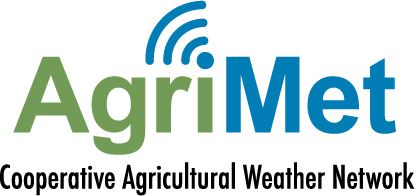
AgriMet Precipitation Measurements
The AgriMet weather station network uses two types of precipitation gages: Tipping Bucket Gages and Belfort-Style Storage Gages. Both of these gages have their advantages and disadvantages. AgriMet collects data from both of these gages in a cumulative format. The tipping bucket gages continue to increase until they reach a maximum of 50" or the power is reset to the datalogger. At that point the value is reset to zero and the counter continues to increase. The storage gages continue to increase until they are recharged (drained of their precipitation catch and partially refilled with an antifreeze solution). A more detailed description of each of these gages can be found below.
All precipitation gages have an undercatch component when it comes to measuring snowfall. This is especially a problem with tipping bucket gages (see below) and with unshielded storage gages. All AgriMet gages are unshielded. See AgriMet Weather Station Instrumentation for the type of precipitation gage used at each station. As a general rule, tipping bucket gages are used in high precipitation zones and storage gages are used in areas where snowfall accounts for a significant portion of the total annual precipitation.
Only one precipitation parameter is transmitted from an AgriMet weather station: cumulative precipition (parameter code PC). These hourly values are available from the Hourly/15 Minute Weather Data web page. The midnight PC value is used in computation of several other parameters in the Archive Weather dataset. These parameters include:
- PC: The hourly telemetered cumulative PC reading at midnight (beginning of the day).
- PP: 24 hour precipitation catch, midnight to midnight (PC today minus PC yesterday)
- PU: Water year total precipitation to date. This is the sum of all PP values since October 1.
It should be noted that precipitation measurements do not enter into the computation of evapotranspiration (ET). Precipitation amounts vary considerably over small areas, especially during summer convectional rainfall (thunderstorms). ET values are more consistent over larger areas.
Tipping Bucket Precipitation Gages
Tipping bucket precipitation gages do not store precipitation. Liquid water captured in the orifice of the gage is funneled down and drops into one of two small cups on either end of a pivoting "see-saw" beam. When the cup reaches a calibrated weight (typically equivalent to 0.01" of precipitation), the beam drops, activating a switch closure, emptying the cup, and bringing the other cup up into position for the next precipitation increment. The switch closure is recorded as a "count" of incremental precipitation. AgriMet gages are calibrated to count increments of 0.01 inches. Because tipping bucket gages do not require maintenance visits to empty them, they are utilized in areas of high precipitation.
Advantages: Since tipping bucket gages do not store the accumulated precipitation, they never require a maintenance visit to empty them, therefore maintenance costs are lower. There is usually never any drift in the measurements: counts are definite and discrete.
Disadvantages: Tipping bucket gages are very inefficient when it comes to solid precipitation. If snow fills the funnel on the top of the gage, any additional snowfall typically blows away. When the snow melts (usually on a warmer or sunny day after the precipitation event), the precipitation count is delayed and usually reduced from the actual event. Heated tipping buckets improve the catch of frozen precipitation, but these gages require AC power which is only available at a limited number of AgriMet stations. During extremely high precipitation intensity, a tipping bucket gage may undercatch the actual precipitation due to the time it takes for the two cups to change position. And finally, the calibration and accuracy of the gage may drift due to the accumulation of dust and dirt in the cups or in the bearings. All AgriMet stations are calibrated annually, and this procedure includes calibration of precipitation gages.
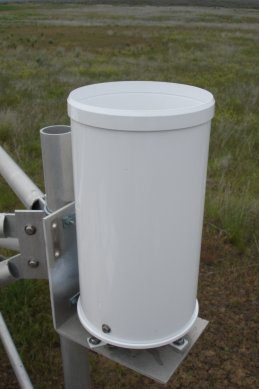
|
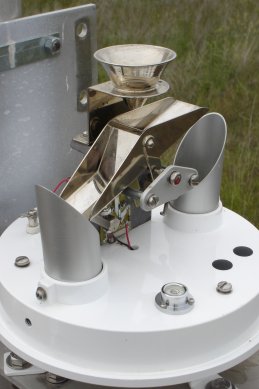
|
| Tipping Bucket Precipitation Gage | Tipping Bucket Mechanism |
Storage Precipitation Gages
Belfort-style storage gages consist of a bucket to store the precipitation; a weighing device to weigh the bucket and the stored precipitation; and an outer shell to cover the bucket and weighing device. All storage gages used by AgriMet are charged with an antifreeze solution and a covering of mineral oil. The antifreeze solution melts and mixes solid precipitation, and the mineral oil prevents evaporation. Because it is a storage type gage, the gage must be recharged when it approaches its capacity. AgriMet storge gages have a 20" capacity. When the gage is recharged, the waste fluid is captured and recycled by a commercial recycler.
Prior to 2008, the AgriMet program used the Belfort Universal Storage Gage in the weather station network. In 2008, AgriMet began upgrading these gages to a new load cell technology. This technology produces more stable data, has a higher catch capacity, is less prone to blowing fuses, and is more cost-effective. By spring of 2011, all Belfort Universal gages were upgraded to the new load cell technology.
Advantages: Storage gages capture all forms of precipitation: both liquid and solid.
Disadvantages: Because of the sensitivity of the weighing device and associated electronics, the telemetered precipitation value can exhibit fluctuations. These fluctuations are related to temperature, but comparison of midnight to midnight readings are fairly consistent. Antifreeze solution is expensive, and requires additional effort to capture and recycle. In addition to capturing precipitation, the gages occasionally catch other airborne objects, like birds, which can cause apparent precipitation increases during a dry period. And finally, maintenance costs are considerably higher than with tipping bucket gages since the storage gages must be emptied when they approach their capacity.
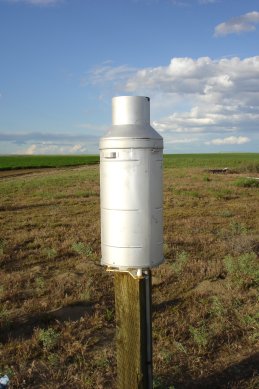 |
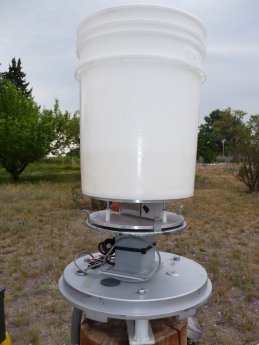 |
| Belfort Stye Precipitation Gage | Load Cell Gage and Bucket (Shield Removed) |

